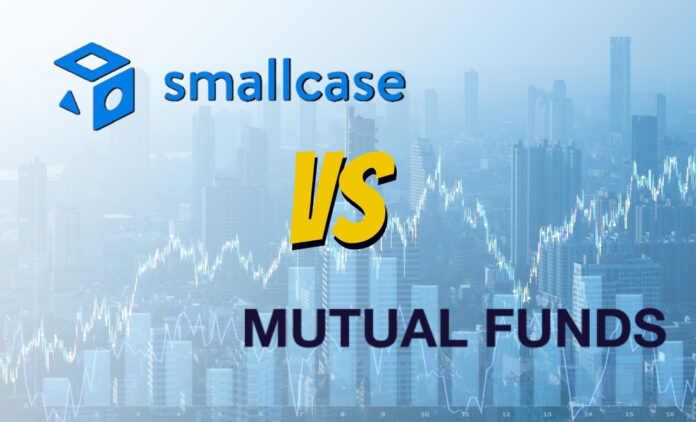Mutual Funds are pooled assets that are managed by experienced professionals hired by the AMCs whereas anyone who is registered with SEBI as an Investment Advisor or Research Analyst can create a Smallcase to which an investor can subscribe.
We have divided the comparison into Costs, Taxation, Returns, Portfolio, Transparency, Risk & Suitability.
Costs
Smallcases come with free & paid options,
Free Smallcases consist of simpler portfolios which include ETFs, thematic, and sectoral portfolios. The “FREE” Smallcases are just there to help you understand how the “product” works. Most “Free” Smallcases other than which include ETFs, are not suitable for an average investor due to high concentration on individual sectors, where even if you choose multiple sectoral Smallcases, in that case, you would just be owning too many stocks, making matters only worse.
Paid Smallcases subscription costs vary. These have a higher frequency of rebalancing & active management to achieve better results. Only subscribe to a smallcase if the percentage-wise costs come out to be lower than 2% which can be calculated as % of fees divided by the Amount to be invested
For eg, if you are looking to invest 2 Lakh Rupees in a Smallcase & the Smallcase itself costs ₹15,000 a year, it would translate into 7.5% per annum, if you are paying 7.5% p.a you would need your smallcase to give at least 7.5% return in a year just to breakeven so, It’s advisable to pay not more than 2% in fees.
Mutual Funds have fees also known as the Expense Ratio which varies from 0.10% to 2% p.a of investment value and an Exit Load of 1% which is applicable only if you exit before a year.
Taxation
Both (Equity MFs & Smallcases) come under Capital Gains, But it works differently in both cases. There are two types of Capital Gains Tax;
Short-Term Capital Gains: When you exit your investments within a year, the profit realised on that investment is taxed at 15% FLAT.
Long-Term Capital Gains: When you exit your investments after a year, the profit realised on that investment is tax-free to an extent of ₹1 Lakh, profit above 1 Lakh is taxed at 10% FLAT.
The Twist: When you reshuffle your Smallcase portfolio and you realise any profit on investments you sell become taxable at a rate of 15% if the investment was held for less than a year. On the other hand in the case of Mutual Funds, when the fund manager reshuffles the portfolio of the scheme the taxability doesn’t arise. The taxability only arises when an investor exits from the scheme itself.
This is a huge disadvantage of Smallcase, the post-tax returns of a Smallcase could be a lot lower than what is presented on the website.
Returns
Smallcases do have a higher chance of outperforming the market & Mutual Funds due to less number of stocks in a Smallcase, most adopting a concentrated portfolio approach by owning not more than 20 stocks in a Smallcase. The CAGR you see on Smallcase doesn’t necessarily translate to real returns (post-tax & charges) because there’s a possibility that the CAGRs mentioned may have been achieved by frequent reshuffling of stocks. More transactions translate into more charges, which may damage your post-expense returns in a big way.
Mutual Funds, on the other hand, are expected to give close to market returns i.e the Index. The past returns mentioned on websites are post-expense past performance.
Risk
Smallcase: Concentrated & Momentum approach followed by most smallcases while may translate into lucrative returns in a bull market, It may backfire when the market cycle reverts. Having said that an Investment Advisor can choose to go in cash for a large part of the portfolio or shift to safer bets. Risk in Smallcases depends a lot on the competency, knowledge & experience of the Advisor.
Mutual Funds: An average mutual fund portfolio consists of 35 to 60 stocks & follows a diversified approach. A mutual fund’s risk is equivalent to that of an Index. Cash holding in a mutual fund scheme doesn’t exceed 10% limiting the ability of a Mutual Fund manager to minimise market risk.
Transparency
Smallcase: Changes made in a Smallcase are made known to you in no time, your smallcase portfolio holdings show up in your Demat account just like other stocks that you have invested in, and the purchase price of a stock is also known to you. The performance of the Smallcase can be tracked in real-time. But there is a problem, you will only know the securities or sector allocation in a smallcase after you subscribe to it.
Mutual Funds: A portfolio of schemes is released by the AMC every month, which includes all the detail about the portfolio & securities held by the scheme, except the average cost. NAV & day’s performance is updated once a day by the AMCs.
Suitability:
- If you have a small amount to invest, you are better off investing in a Free Smallcase with ETFs or in Mutual Funds.
- Someone looking to chase momentum for higher returns also bearing in mind the relatively higher risk involved can choose Smallcase.
- Choosing a Premium Smallcase is not easy, and even more difficult to analyse than a mutual fund, why? A portfolio of a smallcase is not known to you before you subscribe to it. The only benchmark you have to judge a scheme is by historical performance which ignores the costs & capital gains tax due to reshuffling. When purchasing a Smallcase you better be knowing who is the manager of the Smallcase & be confident in his or her abilities to manage a portfolio.









